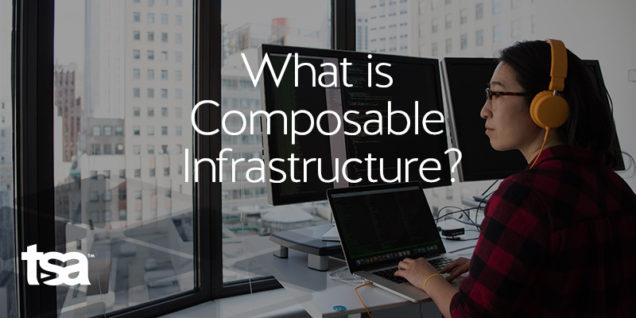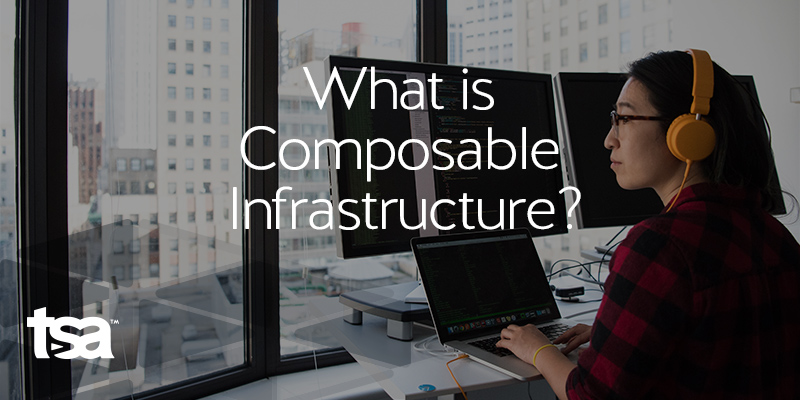Inflexible architectures prevent you from having the power and scalability to thrive in ever-expanding conditions. With limited mobility, customization, and agility to speak of, modern businesses are searching for a solution that is without compromise—a technological panacea that addresses the whole of their IT needs rather than simply solving a portion of them. In short, we need infrastructure reform.
Traditional, Converged, and Hyper-converged
But before we can discuss the next stage of composable infrastructure, it’s important to clearly understand the most prevalent infrastructure offerings on the market: traditional, converged, and hyper-converged systems.
Traditional Infrastructure
A traditional infrastructure is built using siloed components: separate storage, application servers, networking, and backup units that are interlinked by a physical network (all of which need to be configured separately). While, arguably, this level of siloed customization can be beneficial to a certain subset of organizations, too many individualization requirements can become taxing on many company’s IT resources. Disjointed at best, traditional infrastructure:
- Cumbersome to deploy and manage
- More expensive due to the underutilization of resources
- Requires a large IT force of specialized engineers (for different servers, hardware providers, vendors, applications, security technology, etc.)
- Complicates upgrade initiatives and cloud deployments
Converged Infrastructure
Slightly more streamlined, converged infrastructures offer combined storage, compute, and networking switches in a single, turn-key system that is most often pre-configured for specific workloads (simplicity over choice). This combining of elements simplifies IT processes, increases speed-to-delivery, and ultimately reduces datacenters’ physical and power footprints. Despite its added benefits over traditional infrastructures, however, converged has its fair share of limitations, including:
- Lack of flexibility due to pre-configured workloads (no piece/part configuring here)
- Restricted vendor selection due to “locked-in” nature of hardware
- Limited “tinkering” (updates, coding, and patches come directly from OEM)
- 20-50% more expensive to configure and maintain
Hyper-converged Infrastructure
Hyper-converged infrastructure (HCI) takes converged one step further by combining all aspects of networking, compute, and storage systems into a single solution and layering software-defined management on top. Although both are pre-configured, hyper-converged provides seamless integration and improved flexibility through these software-defined capabilities and interfaces rather than through physical cabling and connections. Due to this centralized virtualization, you now get simplicity and choice over your network configurations. HCI enables powerful all-in-one solutions that can even be deployed at the very edge—so that you have datacenter power located exactly where you need it. In fact, HCI has enabled some pretty creative answers to complex problems that we’ve faced.
But, as the pattern continues, while it does provide increased power, scalability, and agility, hyper-converged, it also suffers from similar limitations as its predecessors:
- Expensive to migrate, deploy, and upgrade
- Performance potential of storage I/O fluctuates considerably (due to software competition between hosted VMs and other CPU cycles)
- Not scalable enough for the speed at which some environments are changing (cluster scaling and resources get off-balance)
Due to the limitations and hidebound nature of the above reference architectures, IT developers worked to redefine the way in which infrastructure could be managed. Their next-generation solution? Composable infrastructure.
What Sets Composable Infrastructure Apart from the Rest?
Composable infrastructure—also known as “infrastructure as code”—is a software-defined solution that combines the myriad components of physical and virtual networks into a single, turn-key solution. However, unlike traditional, converged, and hyper-converged, composable infrastructure treats compute, storage, and network devices as pools of resources that can be provisioned as needed. Think of composable like the scalable, adaptable environment of public cloud (except that composable can operate on-premise in enterprise datacenters). Composable infrastructure eliminates the need for app-specific hardware configurations while simultaneously redirecting the management of an entire IT infrastructure to software command.
By effectively removing the siloed management constructs of its predecessors, composable infrastructure virtualizes entire IT environments, allowing them to be managed and optimized via a single virtualized portal. IT teams can now re-configure resource allocations in real-time to generate the exact-sized compute environment that each workload needs. This level of control and of resource-allocation-accuracy starkly reduces underutilization and overprovisioning, thus reducing CAPEX spend.
Moreover, because composable infrastructure allows users to automate infrastructure operations and applications through a unified API, development teams can streamline infrastructure for continuous integration with next-generation deployments using containers and in-house orchestration tools (Ansible, Puppet, Chef, etc.).
Unlike the constructs listed above, composable infrastructure streamlines and combines without limiting reconfiguration and scalability. Industry experts believe that composable infrastructure, with its workload-centric model and scalable solutions, will inspire the next big change within datacenter computing. If you’ve pushed your traditional/converged/hyper-converged infrastructure as far as it can go, perhaps it’s time to consider composable infrastructure.
Composability Sounds Great, but How Do I Take Advantage of It?
We know that change is difficult, implementations take IT resources, and testing is critical at the data center level. Don’t let the daunting task of infrastructure reform keep you from tapping into the tangible benefits that composable infrastructure provides its adopters.
If you are concerned about how composable infrastructure would work for your environment, consider collaborating with a strategic, knowledgeable partner who can walk you through the transition—ideally, a partner who has extensive experience with implementing and managing composable infrastructure at the enterprise level.
At TSA, we helped to implement the very first composable deployment in North America with HPE Synergy. By leveraging our relevant expertise and dedication, you will establish a composable infrastructure that scales to your needs, enables your hardware and network flexibility, and properly utilizes your resources.

